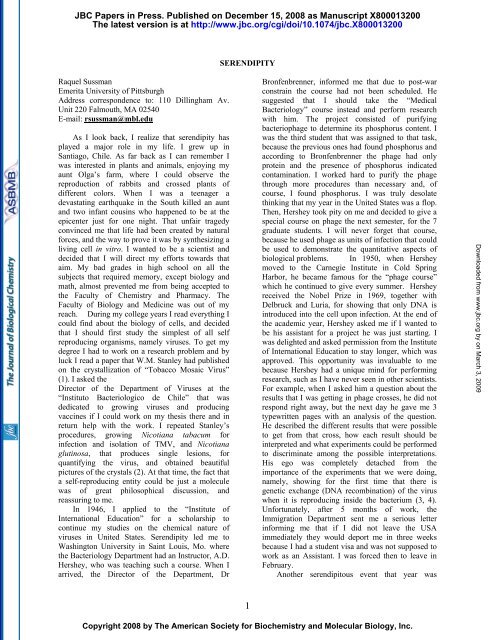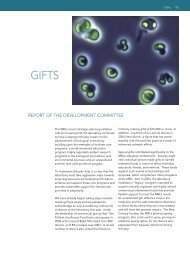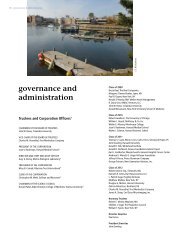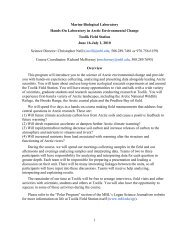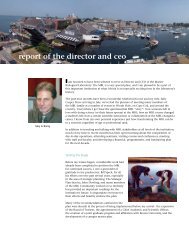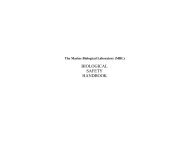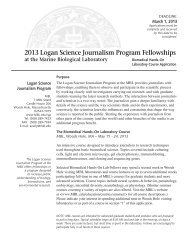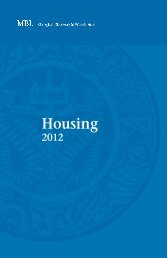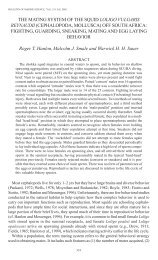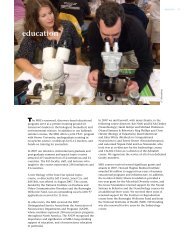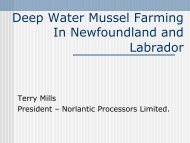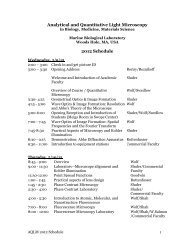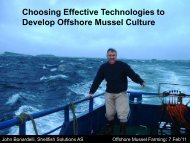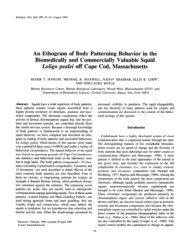PDF - Marine Biological Laboratory
PDF - Marine Biological Laboratory
PDF - Marine Biological Laboratory
Create successful ePaper yourself
Turn your PDF publications into a flip-book with our unique Google optimized e-Paper software.
JBC Papers in Press. Published on December 15, 2008 as Manuscript X800013200<br />
The latest version is at http://www.jbc.org/cgi/doi/10.1074/jbc.X800013200<br />
Raquel Sussman<br />
Emerita University of Pittsburgh<br />
Address correspondence to: 110 Dillingham Av.<br />
Unit 220 Falmouth, MA 02540<br />
E-mail: rsussman@mbl.edu<br />
As I look back, I realize that serendipity has<br />
played a major role in my life. I grew up in<br />
Santiago, Chile. As far back as I can remember I<br />
was interested in plants and animals, enjoying my<br />
aunt Olga’s farm, where I could observe the<br />
reproduction of rabbits and crossed plants of<br />
different colors. When I was a teenager a<br />
devastating earthquake in the South killed an aunt<br />
and two infant cousins who happened to be at the<br />
epicenter just for one night. That unfair tragedy<br />
convinced me that life had been created by natural<br />
forces, and the way to prove it was by synthesizing a<br />
living cell in vitro. I wanted to be a scientist and<br />
decided that I will direct my efforts towards that<br />
aim. My bad grades in high school on all the<br />
subjects that required memory, except biology and<br />
math, almost prevented me from being accepted to<br />
the Faculty of Chemistry and Pharmacy. The<br />
Faculty of Biology and Medicine was out of my<br />
reach. During my college years I read everything I<br />
could find about the biology of cells, and decided<br />
that I should first study the simplest of all self<br />
reproducing organisms, namely viruses. To get my<br />
degree I had to work on a research problem and by<br />
luck I read a paper that W.M. Stanley had published<br />
on the crystallization of “Tobacco Mosaic Virus”<br />
(1). I asked the<br />
Director of the Department of Viruses at the<br />
“Instituto Bacteriologico de Chile” that was<br />
dedicated to growing viruses and producing<br />
vaccines if I could work on my thesis there and in<br />
return help with the work. I repeated Stanley’s<br />
procedures, growing Nicotiana tabacum for<br />
infection and isolation of TMV, and Nicotiana<br />
glutinosa, that produces single lesions, for<br />
quantifying the virus, and obtained beautiful<br />
pictures of the crystals (2). At that time, the fact that<br />
a self-reproducing entity could be just a molecule<br />
was of great philosophical discussion, and<br />
reassuring to me.<br />
In 1946, I applied to the “Institute of<br />
International Education” for a scholarship to<br />
continue my studies on the chemical nature of<br />
viruses in United States. Serendipity led me to<br />
Washington University in Saint Louis, Mo. where<br />
the Bacteriology Department had an Instructor, A.D.<br />
Hershey, who was teaching such a course. When I<br />
arrived, the Director of the Department, Dr<br />
SERENDIPITY<br />
1<br />
Bronfenbrenner, informed me that due to post-war<br />
constrain the course had not been scheduled. He<br />
suggested that I should take the “Medical<br />
Bacteriology” course instead and perform research<br />
with him. The project consisted of purifying<br />
bacteriophage to determine its phosphorus content. I<br />
was the third student that was assigned to that task,<br />
because the previous ones had found phosphorus and<br />
according to Bronfenbrenner the phage had only<br />
protein and the presence of phosphorus indicated<br />
contamination. I worked hard to purify the phage<br />
through more procedures than necessary and, of<br />
course, I found phosphorus. I was truly desolate<br />
thinking that my year in the United States was a flop.<br />
Then, Hershey took pity on me and decided to give a<br />
special course on phage the next semester, for the 7<br />
graduate students. I will never forget that course,<br />
because he used phage as units of infection that could<br />
be used to demonstrate the quantitative aspects of<br />
biological problems. In 1950, when Hershey<br />
moved to the Carnegie Institute in Cold Spring<br />
Harbor, he became famous for the “phage course”<br />
which he continued to give every summer. Hershey<br />
received the Nobel Prize in 1969, together with<br />
Delbruck and Luria, for showing that only DNA is<br />
introduced into the cell upon infection. At the end of<br />
the academic year, Hershey asked me if I wanted to<br />
be his assistant for a project he was just starting. I<br />
was delighted and asked permission from the Institute<br />
of International Education to stay longer, which was<br />
approved. This opportunity was invaluable to me<br />
because Hershey had a unique mind for performing<br />
research, such as I have never seen in other scientists.<br />
For example, when I asked him a question about the<br />
results that I was getting in phage crosses, he did not<br />
respond right away, but the next day he gave me 3<br />
typewritten pages with an analysis of the question.<br />
He described the different results that were possible<br />
to get from that cross, how each result should be<br />
interpreted and what experiments could be performed<br />
to discriminate among the possible interpretations.<br />
His ego was completely detached from the<br />
importance of the experiments that we were doing,<br />
namely, showing for the first time that there is<br />
genetic exchange (DNA recombination) of the virus<br />
when it is reproducing inside the bacterium (3, 4).<br />
Unfortunately, after 5 months of work, the<br />
Immigration Department sent me a serious letter<br />
informing me that if I did not leave the USA<br />
immediately they would deport me in three weeks<br />
because I had a student visa and was not supposed to<br />
work as an Assistant. I was forced then to leave in<br />
February.<br />
Another serendipitous event that year was<br />
Copyright 2008 by The American Society for Biochemistry and Molecular Biology, Inc.<br />
Downloaded from<br />
www.jbc.org by on March 3, 2009
meeting Maurice Sussman, who was Sol<br />
Spiegelman’s graduate student. He was very<br />
intelligent, totally engrossed in research and we<br />
became inseparable. In 1948 I came back to the US<br />
to marry him. I also became Spiegelman’s graduate<br />
student.<br />
At that time, performing science with Sol was<br />
another unique experience. He was only a few years<br />
older than us, with not many more years of scientific<br />
experience, but talked as an old pro. He always had<br />
one problem dominating his mind and thought about<br />
it 18 hours a day. We had coffee breaks every 4<br />
hours to talk about experiments and we worked until<br />
11PM. The problem that he assigned to me was<br />
Saccharomyces chevalieri’s “long term adaptation”<br />
to galactose utilization(5). This strain of yeast<br />
required days of contact with galactose before the<br />
population became positive, in contrast with other<br />
strains of yeast that adapted in a few hours. I was<br />
supposed to find out its mechanism. Sol already had<br />
a working hypothesis that this strain had<br />
“plasmagenes” that controlled the synthesis of the<br />
new enzymes and he expected me to prove it. The<br />
first possibility was that a few cells in the growing<br />
population spontaneously mutated to gal + , followed<br />
by selection. I used the statistical analysis of Luria<br />
and Delbruck (6) to determine whether this was the<br />
mechanism. My results clearly showed that it was a<br />
massive population change requiring the continuous<br />
presence of galactose. At that time there were no<br />
available techniques to determine whether it was a<br />
cytoplasmic or a nuclear phenomenon. Nevertheless,<br />
Sol published my results as: “On the cytoplasmic<br />
nature of long term adaptation in yeast” (7). It took<br />
47 years to shed light on that phenomenon: a paper<br />
published in 1997 (8), showed the “two step model”<br />
of gal operon induction, involving three specific<br />
interacting proteins, necessary to start transcription<br />
of the gal promoter in the nucleus. Later Sol<br />
contributed significantly to science, always in a<br />
pioneering way, for example studying viruses that<br />
induce cancer. One example of his creative mind<br />
was demonstrating the in vitro evolution of an RNA<br />
virus (9).<br />
In 1950 I had my first son, Paul, and we moved<br />
to Evanston, Ill, because Maurice had accepted an<br />
appointment as Instructor and established a lab in<br />
the Biology Department at Northwestern University.<br />
Maurice wanted to apply the powerful approaches of<br />
the newly constituted discipline of Molecular<br />
Biology to phenomena of cell differentiation and<br />
morphogenesis that attend the genesis of<br />
multicellular organization. He chose to study the<br />
cellular slime molds, primitive amoebae that<br />
displayed two distinct and separate phases, namely,<br />
2<br />
growth and differentiation. He established controlled<br />
conditions to study their development in sufficient<br />
number and synchronously to be able to identify and<br />
study the kinetics and logistics of key biochemical<br />
events, particularly the synthesis of new proteins that<br />
attend differentiation into fruiting body (10).<br />
I wanted children, and although taking care of<br />
them has always been my first priority, I did not want<br />
to quit science completely in doing so. However, at<br />
that time, no lab would hire a woman with a child<br />
and able to work only part-time. So I started work in<br />
Maurice’s lab for 2 hours a day. Two more sons came<br />
along 3 and 4 years apart. Our income was very low<br />
and we could not afford baby sitters. Moreover,<br />
in those days, fathers did not participate in the daily<br />
care of the offspring. My mother came to my rescue,<br />
because she understood my passion for science so<br />
with the last two babies she left the family in Chile<br />
and came to help me for 8 months each trip. With her<br />
overseeing the children I was able to increase the<br />
hours I spent in the lab. The focus of Maurice’s<br />
research at that time was to isolate mutants that grow<br />
normally but have aberrant morphogenesis (11-14).<br />
In 1958 we moved to the Biology Department of<br />
Brandeis University in Waltham MA (with a<br />
professorship for Maurice but no academic<br />
appointment for me), where we found excellent<br />
graduate students and an exciting scientific<br />
atmosphere. The Chairman of Biochemistry, Nathan<br />
Kaplan, was a genius in recruiting young scientist<br />
with creative minds. He arranged to have our lab<br />
adjacent to the biochemistry labs. People that<br />
happened to meet in the hall started to talk about their<br />
latest scientific results, which led to open discussions.<br />
I would not have been able to learn the latest<br />
techniques in molecular biology and apply them to<br />
slime molds without the daily contact with Julius<br />
Marmur (15) who was so generous sharing the latest<br />
information, Larry Grossman (16), and Gordon Sato<br />
(17) among others. I continued to collaborate with the<br />
ongoing research in our lab, which had more students<br />
and post-docs (18 - 21), and was able to show that<br />
vegetative amoebae fused producing heterozygotes<br />
that segregated in a Mendelian fashion (22).<br />
In 1961, we took a sabbatical year to work at the<br />
Pasteur Institute in Paris. I chose to work with<br />
François Jacob and upon arrival told him that I was<br />
interested in studying repressors of lysogenic viruses.<br />
These bacterial viruses, upon infection, had a choice<br />
of either express most of its genes, thereby<br />
reproducing, lysing the host and producing clear<br />
plaques on the bacterial lawn, or to express only two<br />
genes – CI and CII - which repressed all the lytic<br />
genes and produced turbid plaques. At that time the<br />
repressors were inferred from clear plaque mutations<br />
Downloaded from<br />
www.jbc.org by on March 3, 2009
in these two loci that complemented each other.<br />
Their chemical nature was still unknown since they<br />
had not been isolated yet. François went to his stock<br />
of lambda phages and gave me vials of several<br />
mutants that according to him were “bizarre”. I<br />
plated them, they all had the clear phenotype, but<br />
their complementation to the CI group was peculiar.<br />
I kept plating them, but had no clue why they<br />
behaved differently. Serendipity again occurred one<br />
day when I removed the agar plates from the 37 o<br />
incubator and all the plaques of the CI 857 mutant<br />
were turbid. I immediately looked at the temperature<br />
of the incubator and it was one degree lower, which<br />
meant that the mutation produced a temperature<br />
sensitive repressor, implying that it was a protein.<br />
After determining all the parameters affecting its<br />
induction (the denaturation curve was very sharp<br />
with a T m at 36 o - 37 o C) we published the paper<br />
in Comptes Rendues (23). One day François told me<br />
that Jacques Monod had suggested that if repressors<br />
are proteins, I should be able to isolate mutants that<br />
are clear on the regular E. coli indicator strain, but<br />
turbid in suppressor strains of E. coli, since these<br />
strains contain mutant tRNAs that insert the right<br />
amino acid in response to the mutated codon,<br />
producing active repressor. I succeeded in isolating<br />
several mutants and we published these results again<br />
in Comptes Rendue (24). These mutants were very<br />
useful later in constructs of plasmids with genes<br />
inducible by shifts in temperature. They also<br />
allowed Mark Ptashne to isolate and purify lambda<br />
repressor (25). My detailed data on the properties of<br />
these phages was never published in an English<br />
Journal, but upon my return I was invited to present<br />
the work at the Dept. of Genetics of Yale University<br />
and at Harvard Medical School.<br />
Back at Brandeis, Maurice started to focus on<br />
the appearance and disappearance of proteins during<br />
morphogenesis (26) and I analyzed the RNA<br />
metabolism, comparing the growing cells to the<br />
differentiating ones (27). For this project I had to<br />
use Polysphondelium pallidum, a slime mold that<br />
was able to grow axenically, finding that ribosomal<br />
RNA was synthesized continually, including<br />
through the process of differentiation, at a time<br />
when not only the nutrients were absent, but when<br />
the cells were degrading the existing RNA and<br />
protein (26). The common knowledge at the time<br />
was that “shift-down” conditions were correlated<br />
with inhibition of ribosomal RNA and ribosomal<br />
protein synthesis. We speculated that the mRNA<br />
synthesized during differentiation required<br />
specialized ribosomes, coded from different genes<br />
than the ones used in the vegetative state. To answer<br />
3<br />
that question, I took advantage of a hybridization<br />
procedure that had just been designed by Gillespie<br />
and Spiegelman (28), based on competition<br />
hybridization of labeled rRNAs from vegetative and<br />
differentiating cells, to P. pallidum DNA. We<br />
showed that both ribosomal messages competed<br />
equally well for the complementary DNA sequences,<br />
indicating that the same genes coded them. As<br />
control we used D. discoideum DNA, which only<br />
allowed partial competition, as expected from a<br />
different rRNA sequence (27). The other hypothesisthat<br />
new messenger RNA has to be transported from<br />
the nucleus to the cytoplasm by nascent ribosomes-<br />
remains untested. While we were speculating about<br />
ribosomes, Alexander Rich in MIT showed that<br />
proteins were synthesized in large ribosomal<br />
aggregates, which he called polyribosomes (29). I<br />
collaborated with his post-doc, W. D. Phillips,<br />
showing that the primitive slime molds also<br />
synthesized proteins in polyribosomes (30).<br />
During those 22 years that I worked on<br />
Dictyostelium I never received any remuneration.<br />
Maurice and I had agreed that it was not ethical to<br />
ask a Granting Agency to pay the wife of the PI. I am<br />
reflecting on this only to stress how unfair the<br />
treatment of women in science was in those times and<br />
in our case how brainwashed scientists could be.<br />
In 1973 I became independent to pursue my own<br />
choice of scientific problems when we accepted an<br />
invitation to work at the Hebrew University in<br />
Jerusalem. I was appointed “Martze Bahir”<br />
(equivalent to Associate Professor) in the Department<br />
of Molecular Biology at Hadassah Medical School. I<br />
had my own lab and started to work on a problem<br />
that interested me greatly: the phenomenon of “SOS<br />
repair” in bacteria. The publication of Evelyn Witkin<br />
(31) had inspired me and even before I had the<br />
possibility to work on that problem I already had a<br />
hypothesis to explain why damage to the bacterial<br />
chromosome or inhibition of DNA replication<br />
elicited a number of seemingly unrelated phenomena:<br />
cessation of cell division, inhibition of septum<br />
formation leading to filamentation, increased<br />
mutagenesis, production of colicin and de-repression<br />
of lysogenic viruses. I had learned a great deal about<br />
DNA repair from Larry Grossman and proposed that<br />
the affected genes were controlled by repressors like<br />
in lambda phage, that were present at very low<br />
concentration, sufficient to inhibit transcription of its<br />
operon. During repair of the chromosome several<br />
intermediates of the DNA helix are produced and if<br />
the repressors had affinity for a specific DNA repair<br />
product they would bind to it when present, thus<br />
decreasing the effective concentration needed to<br />
silence their own operators.<br />
At Hebrew University I finally had a chance to<br />
Downloaded from<br />
www.jbc.org by on March 3, 2009
test the hypothesis, and serendipity brought Hanna<br />
BenZeev, who applied to be my technician. She was<br />
extremely competent and intelligent. To prove the<br />
hypothesis, we used a competition filter binding<br />
assay, with extracts of lambda repressor and<br />
radioactive DNA and showed that E coli DNA did<br />
not compete in the binding of repressor to lambda<br />
DNA, whereas DNA extracted from bacteria<br />
undergoing SOS repair did compete. Moreover, the<br />
non-inducible repressor (ind - ), used as control, did<br />
not compete. Also, increasing the DNA damage of<br />
the bacteria resulted in DNA with increased<br />
interference in the competition assay (32). Only two<br />
and a half years later, when we moved to the<br />
University of Pittsburgh, I had a chance to purify<br />
repressor and to prepare E coli DNA containing<br />
different specific lesions in Larry Grossman’s lab.<br />
We proved that lambda repressor had greater<br />
affinity for double stranded DNA containing single<br />
strand gaps (33). Nevertheless, it turned out that my<br />
hypothesis was wrong: Roberts, Roberts, and Mount<br />
(34) established that recA was the protein that bound<br />
to ss DNA was activated to cleave the repressors. I<br />
still have the intuition that repressors’ affinity for<br />
gapped ssDNA is necessary to increase their local<br />
concentration at the RecA /ssDNA catalytic site.<br />
Serendipity continued at the University of<br />
Pittsburgh, where two of the brightest graduate<br />
students applied to work in my lab: Jim Resnick and<br />
John Baluch. We established many important<br />
parameters of the SOS repair mechanism (35– 39).<br />
At that time I had to work very hard to get tenure:<br />
teaching new courses every semester, getting good<br />
evaluation from students, enough publications and,<br />
of course, continued support from NIH and NSF.<br />
The Grants lasted long after I got tenure, took early<br />
retirement from the U. of Pittsburgh at 66, and<br />
became an Associate Scientist at the <strong>Marine</strong><br />
<strong>Biological</strong> <strong>Laboratory</strong> in Woods Hole. The move<br />
was motivated by our desire to be close to our<br />
children, who lived in Massachusetts.<br />
My fascination for RecA, a mere 37.8 Kd<br />
protein, the physiological equivalent of the<br />
vertebrate p53, exhibits a great number of<br />
sophisticated enzymatic activities, necessary to<br />
protect the bacterial cell from diverse injuries<br />
(review (40)). This protein forms a helical complex<br />
with ssDNA and NTP for all these activities. One<br />
subset of the activities require a high RecA/DNA<br />
ratio and no hydrolysis of NTP (the co-protease<br />
activity and D loop formation) whereas the other<br />
subset requires NTPase activity necessary for<br />
recombination of two homologous duplexes, The<br />
work that I consider my best is postulating that<br />
RecA undergoes an allosteric change in<br />
4<br />
structure/function dictated by the number of<br />
nucleotides available when forming the required<br />
ternary complex (41). The dynamics envisioned for a<br />
cell that undergoes a DNA lesion is the following:<br />
When pollII encounters a distorted chromosome, it<br />
cannot proceed replicating the DNA, giving rise to<br />
small ssDNA gaps. SSB present in large<br />
concentration in the cell binds to the ssDNA to<br />
protect it from DNAases. Crysogelos& Griffith (42)<br />
established that SSB organizes the ssDNA into<br />
nucleosome-like loops linked by 30 bases of free of<br />
protein. We have shown that RecA binds to these<br />
linkers with a stoichiometry of 8 RecA monomers per<br />
linker, that is, 3 – 4 nucleotides/monomer (39). This<br />
turns out to be the saturated complex, exhibiting the<br />
highest co-protease activity, designated state “a”<br />
(RecA * ). Thus, the complex proceeds to catalyze the<br />
cleavage of LexA thereby derepressing the genes<br />
under its control, including, recA, sfiA, and umuD<br />
which has to be cleaved by RecA * to become a<br />
subunit of pol V. This polymerase is competent to<br />
replicate DNA containing lesions, which is probably<br />
repressed under normal cell life because it is error<br />
prone. Pol V proceeds to enlarge the ss DNA gap,<br />
thus allowing RecA to contact more nucleotide<br />
phosphates, changing to state “b”, which is proficient<br />
as an ATPase and becoming a recombinase. If this<br />
were correct, it would be the first example of a<br />
protein responding to the specific requirements of the<br />
cell by changing catalytic activities.<br />
In spite of the excellent studies performed<br />
analyzing complexes of RecA with ssDNA and<br />
dsDNA, we still do not know its atomic interactions<br />
with DNA, which requires crystallization. Until now<br />
that task was impossible due to the dynamism of the<br />
system. Our contribution to this problem is to show<br />
that small oligos, in the presence of ATP -S, retain<br />
enzymatic activities and are very stable: the<br />
RecA/dT 16 behaves like a saturated complex<br />
catalyzing repressors’ self-cleavage, whereas<br />
RecA/dT 24 has ATPase activity necessary for<br />
ssDNA recombination (40). I believe that these stable<br />
complexes will be easy to crystallize thus helping to<br />
establish its structure/function.<br />
I am very fortunate to have witnessed the birth<br />
and development of Molecular Biology.<br />
Acknowledgments—I am extremely grateful to<br />
Susana Levy and Jane McLaughlin for correcting a<br />
draft of this manuscript and providing many helpful<br />
comments.<br />
Downloaded from<br />
www.jbc.org by on March 3, 2009
REFERENCES<br />
1. Stanley, W.M. (1935) Isolation of a crystalline<br />
protein possessing the properties of Tobacco mosaic<br />
virus. Science 28, 644-645<br />
2. Rotman, Raquel (1944) Ensayo de purificacion del<br />
Virus del Mosaico del Tabaco. Thesis. Universidad<br />
de Chile.<br />
3. Hershey, A.D., and Rotman, R. (1948) Linkage<br />
among genes controlling inhibition of lysis in a<br />
bacterial virus. Proc. Natl. Acad. Sci. U. S. A. 34,<br />
89-96<br />
4. Hershey, A.D., and Rotman, R. (1949) Genetic<br />
recombination between host-range and plaque-type<br />
mutants of bacteriophage in single bacterial cells.<br />
Genetics 34, 44-71<br />
5. Winge, O., and Roberts, C. (1948) Comp. Rend.<br />
Trav. Lab., Carlsb. Ser. Physiol. 24, 263-315<br />
6. Luria, S.E., and Delbruck, M. (1943) Mutations of<br />
Bacteria from Virus Sensitivity to Virus Resistance.<br />
Genetics 28, 491-511<br />
7. Spiegelman, S., Sussman, R., and Pinska, E. (1950)<br />
On the cytoplasmic nature of "long-term adaptation"<br />
in yeast. Proc. Natl. Acad. Sci. U S A. 36, 591-606<br />
8. Yano, K.I., and Fukasawa, T. (1997) Galactosedependent<br />
reversible interaction of Gal3p with<br />
Gal80p in the induction pathway of Gal4p -<br />
activated genes of Saccharomyces cerevisiae. Proc.<br />
Natl. Acad. Sci. U. S. A. 94, 1721-1726<br />
9. Kramer, F.R. Mills, D.R., Cole, P.E., Nishihara, T.,<br />
and Spiegelman, S. (1974) Evolution in vitro:<br />
sequence and phenotype of a mutant RNA resistant<br />
to ethidium bromide. J. Mol. Biol. 89,719-36<br />
10. Sussman, M, (1951) The origin of cellular<br />
heterogeneity in the slime molds, Dictyosteliacae. J.<br />
Exp.Zool.118, 407-418<br />
11. Sussman, R., and Sussman, M. (1953) Cellular<br />
differentiation in the slime molds: heritable<br />
modifications of the developmental pattern. Trans.<br />
N.Y. Acad. Sci. 56 949-960. Princeton University<br />
Press<br />
12. Sussman, M. (1954) Synergistic and antagonistic<br />
interactions between morphogenetically deficient<br />
variants of the slime mould Dyctiostelium<br />
discoideum. J. Gen. Microbiol. 10, 110-20<br />
13. Sussman, M. (1955) Fruity and other mutants of the<br />
cellular slime mould Dictyostelium discoideum: a<br />
study of developmental aberrations. J. Gen.<br />
Microbiol. 13, 295-309<br />
14. Sussman, M., and Sussman, R. (1956) Cellular<br />
interactions during the development of the cellular<br />
slime molds. 14 th Symp. Soc. For Growth and<br />
Development, pp 125-154<br />
15. Marmur, J., and Doty, P. (1962) Determination of<br />
the base composition of deoxyribonucleic acid from<br />
its thermal denaturation temperature. J. Mol. Biol. 5,<br />
109-118<br />
16. Kaplan, J.C., Kushner, S. R., and Grossman, L.<br />
(1969) Enzymatic repair of DNA, Purification of two<br />
enzymes involved in the excision of thymine<br />
dimmers from Ultraviolet-irradiated DNA. Proc.<br />
Natl. Acad. Sci. U. S. A. 63, 144–151<br />
17. Sato, G., Fisher, H.W., and Puck, T.T. (1957)<br />
Molecular growth requirements of single mammalian<br />
cells. Science 126, 961-964<br />
18. Sussman, R., Sussman, M., and Ennis, H.L. (1960)<br />
The appearance and inheritance of the I-cell<br />
phenotype in Dictyostelium discoideum. Dev. Biol. 2,<br />
367-392<br />
19. Sussman, R., and Sussman, M. (1960) The<br />
dissociation of morphogenesis from cell division in<br />
the cellular slime mold Dictyostelium discoideum. J.<br />
Gen. Microbiol. 23, 287-293<br />
20. Sussman, M. and Sussman, R. (1961) Aggregative<br />
performance. Exptl. Cell Res., Suppl. 8, 91-106<br />
21. Sussman, R. (1961). A method for staining the<br />
chromosomes of Dictyostelium discoideum<br />
myxamoebae in the vegetative stage. Exptl. Cell Res.<br />
23, 154-155<br />
22. Sussman, R., and Sussman, M. (1962). Ploidal<br />
inheritance in the slime mold Dictyostelium<br />
discoideum: Haploidization and genetic segregation<br />
of diploid strains. J. Gen. Microbiol. 30, 349-355<br />
23. Sussman, R., and Jacob. F. (1962) Sur un systeme de<br />
repression thermosensible chez le bacteriophage<br />
lambda d'Escherichia coli, Compt. Rend. Acad. Sci.<br />
254, 1517-1519<br />
24. Jacob, F., Sussman, R., and Monod J. (1962) Sur la<br />
nature du represseur assurant l'immunite des bacteries<br />
lysogenes. Compt. Rend. Acad. Sci. 254, 4214-4216<br />
25. Ptashne, M. (1967) Isolation of the lambda phage<br />
repressor. Proc. Natl. Acad. Sci. U.S.A. 57(2), 306-<br />
313<br />
26. Sussman, M. (1966) Protein synthesis and the<br />
temporal control of genetic transcription during slime<br />
mold development. Proc. Nat. Acad. Sci. U.S.A. 55,<br />
813-818<br />
27. Sussman, R. (1967) RNA metabolism during<br />
cytodifferentiation in the cellular slime mold<br />
Polysphondelium pallidum. Biochim. Biophys. Acta<br />
149, 407-421<br />
28. Gillespie, D., and Spiegelman, S. (1965) A<br />
quantitative assay for DNA-RNA hybrids with DNA<br />
immobilized on a membrane. J. Mol. Biol. 12(3),<br />
829-842<br />
29. Kiho, Y, and Rich, A. (1964) Induced enzyme<br />
formed on polyribosomes. Proc. Natl. Acad. Sci. U<br />
.S. A. 51, 111-118<br />
30. Phillips, W.D., Rich, A., and Sussman, R. (1964) The<br />
isolation and identification of polyribosomes from<br />
5<br />
Downloaded from<br />
www.jbc.org by on March 3, 2009
cellular slime molds. Biochim. Biophys. Acta 80,<br />
508-510<br />
31. Witkin, E. M. (1967) The radiation sensitivity of<br />
Escherichia coli B: A hypothesis relating filament<br />
formation and prophage induction. Proc. Natl. Acad.<br />
Sci. U. S. A. 57, 1275-1279<br />
32. Sussman, R., and BenZeev, H. (1975) A proposed<br />
mechanism of bacteriophage lambda induction:<br />
acquisition of binding sites for the lambda repressor<br />
by the induced host DNA. Proc. Natl. Acad. Sci. U.<br />
S. A. 72, 1973-1976<br />
33. Sussman, R., Resnick, J., Calame, K., and Baluch, J.<br />
(1978) Interaction of bacteriophage lambda<br />
repressor with non-operator DNA containing single<br />
strand gaps. Proc. Natl. Acad. Sci. U. S. A. 75, 5817-<br />
5821<br />
34. Roberts, J.W., Roberts, C.W., and Mount D. W.<br />
(1977) Inactivation and proteolytic cleavage of<br />
phage lambda repressor in vitro in an ATPdependent<br />
reaction. Proc. Natl. Acad. Sci. U. S. A.<br />
74, 2283-2287<br />
35. Baluch, J., Sussman, R., and Resnick. J. (1980)<br />
Induction of prophage without amplification of recA<br />
protein. Mol. Gen. Genet. 178, 317-323<br />
36. Baluch, J., Chase, J.W., and Sussman, R. (1980)<br />
Synthesis of recA protein and induction of<br />
bacteriophage lambda in Single-Strand DNA<br />
Binding protein mutants of Escherichia coli. J.<br />
Bacteriol. 144, 489-498<br />
37. Resnick, J., and Sussman, R. (1982). E. coli Single-<br />
Strand DNA Binding protein from wild type and<br />
lexC113 mutant affects in vitro proteolytic cleavage<br />
of phage lambda repressor. Proc. Natl. Acad. Sci. U.<br />
S. A. 79, 2832-2835<br />
38. Resnick, J., and Sussman, R. (1982) Cobalt: An<br />
effector of E. coli recA protein activity. Nucleic<br />
Acids Res. 10, 5239-5235<br />
39. Cohen, S.P., Resnick, J., and Sussman, R. (1983)<br />
Interaction of Single-Strand Binding protein and<br />
RecA protein at the single-strand DNA site. J. Mol.<br />
Biol. 167, 901-909<br />
40. Walker, G.C. (1984) Mutagenesis and Inducible<br />
Responses to Deoxyribonuleic Acid Damage in<br />
Escherichia coli. Microbiological Reviews 48, 60-<br />
93<br />
41. Sussman, R., Sharma, S.K., and Kuzirian, A. (2008)<br />
Catalytic activities of recA protein are dependent on<br />
the lattice length of the single-strand DNA ligand.<br />
Cell Cycle 7: 89-95<br />
42. Chrysogelos, S., and Griffith, J. (1982) Escherichia<br />
coli single-strand binding protein organizes singlestranded<br />
DNA in nucleosome-like units. Proc. Natl.<br />
Acad. Sci. U.S.A. 79, 5803-7<br />
6<br />
Al Hershey, Raquel Sussman and Al’s son Peter<br />
Phage meeting Cold Spring Harbor, NY, 1976,<br />
Gordon Sato and Raquel Sussman<br />
Brandeis University, 1970<br />
Larry Grossman, Maurice Sussman & Julius Marmor<br />
Brandeis University, 1970<br />
Downloaded from<br />
www.jbc.org by on March 3, 2009


